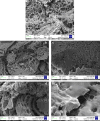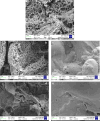The Effects of Die Temperature and Screw Speed on Extruded Pulse Flours and Their Application in Bread Production
- PMID: 40860909
- PMCID: PMC12376178
- DOI: 10.1002/fsn3.70801
The Effects of Die Temperature and Screw Speed on Extruded Pulse Flours and Their Application in Bread Production
Abstract
Extrusion is an innovative technology for improving the techno-functional and nutritional properties of pulse flours. This study aimed to optimize extrusion conditions for broad bean and mung bean flours and to assess their potential in bread making. Die temperature (135°C-165°C) and screw speed (200-300 rpm) were optimized using response surface methodology, with water absorption index (WAI), phytic acid (PA), and insoluble dietary fiber (ISDF) as response variables. Optimal conditions were found to be a 165°C die temperature and a 200 rpm screw speed for both pulses. Die temperature and screw speed had a significant effect on WAI, PA, and ISDF values. Flours obtained under optimum conditions showed the following changes: in mung bean, WAI increased by 50%, whereas PA and ISDF decreased by 59.5% and 30.9%, respectively; in faba bean, WAI increased by 33.69%, whereas PA and ISDF decreased by 45.27% and 29.68%, respectively. Extrusion disrupted starch crystallinity and changed protein-carbohydrate structures as observed by XRD, FTIR, and DSC analyses. Incorporation of pulse flours affected the rheological properties of the bread dough, causing a decrease in viscous and elastic responses. In bread making trials, wheat flour was substituted with pulse flours at 12.5% and 25%. Both substitution levels reduced bread volume and increased crumb hardness. In conclusion, it is shown that extrusion is an effective method for modifying the functional properties of pulse flours, and the use of optimized extrusion as a tool to develop novel functional pulse-based ingredients.
Keywords: bread; broad bean flour; extrusion; mung bean flour.
© 2025 The Author(s). Food Science & Nutrition published by Wiley Periodicals LLC.
Conflict of interest statement
The authors declare no conflicts of interest.
Figures








Similar articles
-
Evaluating the Effectiveness of Extrusion in Fortifying Rice Analogues With Dietary Fiber.J Food Sci. 2025 Aug;90(8):e70443. doi: 10.1111/1750-3841.70443. J Food Sci. 2025. PMID: 40785441
-
Optimization of the extrusion parameters for the production of lentil-quinoa extrudates enriched with pumpkin.Food Sci Technol Int. 2025 Oct;31(7):649-661. doi: 10.1177/10820132241243240. Epub 2024 Mar 31. Food Sci Technol Int. 2025. PMID: 38556930
-
The Use of Whey Powder to Improve Bread Quality: A Sustainable Solution for Utilizing Dairy By-Products.Foods. 2025 Aug 21;14(16):2911. doi: 10.3390/foods14162911. Foods. 2025. PMID: 40870823 Free PMC article.
-
Management of urinary stones by experts in stone disease (ESD 2025).Arch Ital Urol Androl. 2025 Jun 30;97(2):14085. doi: 10.4081/aiua.2025.14085. Epub 2025 Jun 30. Arch Ital Urol Androl. 2025. PMID: 40583613 Review.
-
Intravenous magnesium sulphate and sotalol for prevention of atrial fibrillation after coronary artery bypass surgery: a systematic review and economic evaluation.Health Technol Assess. 2008 Jun;12(28):iii-iv, ix-95. doi: 10.3310/hta12280. Health Technol Assess. 2008. PMID: 18547499
References
-
- AACC . 2000. Approved Methods of Analysis. n.d. Method 44–15A, Moisture–Air‐Oven Method. American Association of Cereal Chemists.
-
- Abbas, I. R. , Scheerens J. C., Tinsley A. M., and Berry J. W.. 1986. “Tepary Bean Starch. Part II. Rheological Properties and Suitability for Use in Foods.” Starch‐Stärke 38, no. 10: 351–354.
-
- Ahmad, M. , Benjakul S., and Nalinanon S.. 2010. “Compositional and Physicochemical Characteristics of Acid Solubilized Collagen Extracted From the Skin of Unicorn Leatherjacket (<styled-content style="fixed-case"> Aluterus monoceros </styled-content>).” Food Hydrocolloids 24, no. 6–7: 588–594.
-
- Akın, P. R. , Tayfun K. E., Tamer U., and Boyacı İ. H.. 2021. “Use of Tea Fibers as a Source of Dietary Fiber in Wheat Flour and Bread.” Cereal Chemistry 98: 1049–1058.
-
- Alam, M. S. , Kaur J., Khaira H., and Gupta K.. 2016. “Extrusion and Extruded Products: Changes in Quality Attributes as Affected by Extrusion Process Parameters: A Review.” Critical Reviews in Food Science and Nutrition 56, no. 3: 445–473. - PubMed
LinkOut - more resources
Full Text Sources

